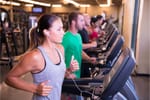Losing weight and keeping it off is becoming increasingly more difficult for much of the population. There are several obvious reasons for this dilemma, with the biggest being the lack of time during any given day.
Currently, people are drowning in their never-ending to-do lists and aren’t able to get caught up.
Can you relate?
Regardless of how busy you are, getting into the best shape of your life must be your number one priority.
Oftentimes it’s easier said than done, but it goes without saying that if you don’t take care of yourself, you can’t take care of anyone else, people such as your loved ones.
One of the best ways to lose weight is to implement some form of tracking into your daily routine because you can’t manage what you don’t measure.
We know you may be thinking to yourself that tracking weight loss sounds like a pain in the rear, but it doesn’t have to be.
The good news is you can make it as simple or complicated as you’d like.
There are several options available to you, and we’ll be sharing ten of the best ways to track your weight loss progress.
Let’s quickly cover them now…
1)) Measure Body Parts
We do not doubt that you’re familiar with using a body fat tape measure to track physical changes.
Even with all the advanced fitness technology available, this is still an excellent method of tracking your weight loss progress, because it’s simple, inexpensive, convenient, and easy to do.
No, it will not tell you what your body fat composition is.
However, it will provide you with a reliable way of knowing whether or not your diet and exercise program is working.
Example Of The Body Parts You Should Measure:
- Neck
- Chest
- Upper Arm (Left)
- Upper Arm (Right)
- Forearm (Left)
- Forearm (Right)
- Waist
- Upper Thigh (Left)
- Upper Thigh (Right)
- Hip
- Calf (Left)
- Calf (Right)
Pro Tips:
- We highly recommend that you take measurements no more than once per week if you are easily discouraged.
- Record your measurements in some type of journal or tracking app.
- Have someone you trust measure your body parts for better accuracy.
Measuring your body parts on at least a weekly or bi-weekly basis should be a priority.
2)) Weigh-ins
These aren’t just for professional athletes such as boxers, you can model what some of the most physically fit people in the world do to help you lose weight.
Why not?
If it works for them, it’ll work for you.
Using a body weight scale to track your weight loss efforts is pretty standard.
It’s the fastest way to tell if you’re dropping those extra pounds, maintaining, or gaining.
Some manufacturers claim their scales can calculate other body composition data such as BMI and body fat percentages.
There’s an ongoing debate about the accuracy of those features offered on body weight scales.
We recommend not getting caught up in that back-and-forth argument and simply using the scale to weigh yourself.
Apply these tips if you plan to use a scale to track your weight:
TIP 1: Purchase A High-Quality Scale
TIP 2: Establish Your Starting Point
TIP 3: Determine Your Weighing Frequency
TIP 4: Beware Of Trends In Your Bodyweight
As we mentioned earlier, do not weigh yourself too often if you get discouraged easily, as this could work against you mentally.
NOTE: If you find that you’re gaining weight as a result of your exercise and diet routine, you may be developing lean muscle tissue, which weighs more than fat. This is why you want to use tracking methods that measure your body composition to determine your fat-to-muscle ratio.
So, be certain to include a body weight scale in your weight loss tracking strategy.
3)) Take Skinfold Measurements
We’ve mentioned body composition several times already and how using a body tape measure and possibly a body weight scale isn’t adequate for calculating BMI and body fat percentages.
Fortunately, taking skinfold measurements is better suited for providing that data.
This method is simply when you use skinfold calipers to measure the thickness of the outer fat on specific parts of your body.
After you have taken the measurements on those specific body parts, you then calculate using one of the many formulas available out there to get your body fat percentages.
Typical Body Part Measurements Are Taken From:
- Triceps
- Suprailliac (located slightly above the hip bone)
- Front Of Upper Thigh (slightly above kneecap)
- Chest (slightly to the right of the nipple)
- Abs (slightly to the right of the navel)
- Subscapular (lower lat muscle)
Like with using a body tape measure, you need to have someone take these measurements for you.
Personal trainers use the skinfold method all the time to calculate their client’s body fat percentages.
You should consider giving this method a try.
4)) Air Displacement Plethysmography
This is a process where you step into an egg-shaped pod with no clothes on, then the machine calculates your body fat percentage based on the density of your body weight.
These machines have proven to be accurate and are said to produce results similar to Hydrostatic Weighing.
The only problem is that the average person doesn’t have access to this device also known as a Bod Pod.
If you’re one of those fortunate individuals, you should make an appointment ASAP!
Tip: Check your health care insurance to see if Air Displacement Plethysmography is covered or not.
5)) Hydrostatic Weighing
This method involves being immersed in water and is considered to be one of the most accurate ways to measure body composition.
The only challenge is that this device is inaccessible to most people unless you know someone in the medical industry.
If you have those types of connections, then, by all means, take ethical advantage of getting your body composition data using hydrostatic weighing.
While accessibility is a problem, we still feel mentioning this method is worth it for those who do but never entertained the idea of using it to get an accurate measurement of their body fat percentages.
6)) Try on Clothes You Plan to Fit Into
Do you have weight loss goals if accomplished would allow you to wear clothes that use to fit perfectly?
Have you been eyeballing some stylish outfits that require you to drop a few pounds?
If so, change the way you think about your situation.
Instead of getting depressed and discouraged about not being able to fit into the clothes you love, use that frustration as motivation.
What we mean by that is, to create a fun challenge where you establish and commit to an exercise program to help melt those extra pounds off your body.
And once per week, try on the clothes that you plan to fit in to see how much progress you’ve made.
Don’t get discouraged because losing weight is a process.
For instance, if you can pull those pants up a little higher on your thighs, you will know that you’ve made some progress and it’ll only be a matter of time before you will be able to pull them up.
You are simply using clothing to track whether or not you’re losing weight.
By the way, you can apply this same technique to clothes you can put on but happen to fit a little snugly. Once per week, you’ll be able to tell whether or not you’re slimming down by how they fit. If they fit more loosely, there’s your answer.
Using clothes as a way to track your weight loss progress is a great alternative to the scale and tape measure.
7)) Take Before and After Photos
Another great method that you can use to track your weight loss progress is to take before and after photos once per week.
You don’t need any expensive cameras and can take shots with your smartphone.
If you’re self-conscious and want to keep your photos private, you must stand in front of a mirror and take the pictures yourself.
You may even want to consider using an app that allows you to place the before and after pictures into a virtual frame so that you can look at them side-by-side.
This will allow you to clearly see your physical progress.
You could print the pictures out and place them into a photo album that’s strictly used to chronicle your weight loss journey.
Over time, you’re going to feel so proud of yourself as you visually see the transformation taking place.
So, don’t underestimate the power of using before and after photos to track your weight loss progress.
8)) Bioelectrical Impedance
According to Wikipedia, Bioelectrical impedance analysis is a method for estimating body composition, in particular body fat and muscle mass, where a weak electric current flows through the body and the voltage is measured in order to calculate the impedance of the body. Most body water is stored in muscles.
Pros
- Pain-free
- Easy to apply
- Quick
Cons
- The machine cost thousands of dollars
- Tends to overestimate body fat in lean individuals
- Tends to underestimate body fat in overweight individuals
This method is worth mentioning because it’s good to know your options for tracking your body weight.
9)) Wearable Technology
Fitness trackers have been all the rage in recent years and like with body weight scales, there are a ton of debates taking place about their accuracy.
I’m going to say it again, don’t get caught up in that drama and instead focus on the positives of wearable fitness technology.
Because at the end of the day, your only objective is to use it as a motivational tool that helps you accomplish your fitness goals.
Most fitness trackers allow you to participate in friendly competitions with people from around the world.
Competitions such as seeing who can walk the most steps on any given day.
This makes fitness fun and allows you to build relationships with others in the name of sculpting the body of your dreams.
So, rather than getting caught up in arguments about how accurate these devices are, use them to help you drop those extra pounds.
If the tracking happens to be accurate, that’s a bonus.
Pro Tip: Read the consumer reviews and check out sites like Consumer Reports.
10)) Physical Weight Loss Trackers
The process of losing weight is so complicated, that people often end up confused and overwhelmed by the mountain of conflicting information.
We are made to believe that you have to do all of these off-the-wall things to get fit.
We're not saying that health and fitness shouldn’t be approached methodically, especially if you have pre-conditions.
But at the same time, if you’re able to, just start exercising at a slow pace and begin replacing junk food with healthy dishes if you’re not up for going cold turkey.
That alone could help you to lose weight.
We said all of that to say this…
When it comes to tracking your weight loss progress, keep it simple, at least in the beginning.
You can always apply more sophisticated tracking methods as you progress along your journey.
One of the simplest ways to track your progress is to use a one-page tracker where you simply fill in your body weight each day, period!
This will give you an at-a-glance look to see your progress.
Just imagine how motivating it would be to see how much weight you’ve just lost over 30 days.
All without complicating the process.
You see, simple systems when executed consistently usually outperform complicated methods.
Complicated processes tend to overwhelm us, and cause inaction, which can ultimately lead to failure in most cases.
Simplicity, ease of use, and effectiveness are why these little one-page weight loss trackers have become so popular.
They are perfect if you don’t want to get caught up in tech overwhelm.
The cool thing is that they’re inexpensive and can be downloaded instantly.
You can print out as many copies as you like and put them in a three-ring binder.
These one-page trackers could be your secret weight loss weapons.
Let’s go ahead and close out…
Conclusion
You just discovered the Top 10 Ways To Track Weight Loss Progress.
The whole point of this article was to make you aware of your options by providing you with some bitesize information on each method.
Having this knowledge allows you to make informed decisions about which methods appeal to you, doing so will only increase your chances of sticking with it long-term.
Throughout this article, you’ve heard us repeat the importance of keeping things simple when it comes to losing weight.
Why complicate the process when it doesn’t need to be?
There’s nothing wrong with using a combination of the ten methods that I covered.
The key is to pick one place to record your body weight and a one-page weight loss tracker is an excellent choice.
You’ll make more progress physically by taking action than getting caught up in planning and research mode.
If this describes you, stop getting ready to get ready!
Pick a way to track your progress and get going.
Are You Looking For The Best Gym In Sacramento CA? Click Here To Get In Touch With One Of Our Fitness Experts At Our Top-Notch Fitness Facility Today!
Download Our Free E-book!








